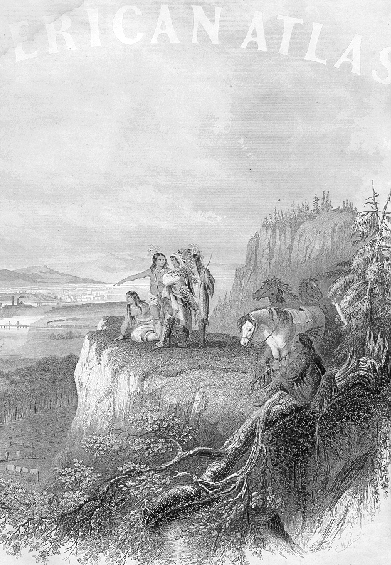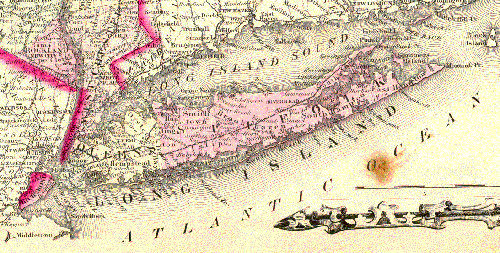
 In his earliest notebooks, Whitman was already piecing together a vision of
the United States as a live organism, stretching from one coast to another.
In the late 1840s, he cut out large sections of G. Woolworth Colton's
popular atlas, Geography and History, American and Modern, and
pasted them into a scrapbook along with newspaper clippings on travel,
geology, history, and archaeology. These notebooks serve as a record of
Whitman's immense intellectual appetite, and his efforts to educate himself
in all the currents of thought of this exciting time. He was particularly
interested in learning about the parts of the country he had never seen,
and compiled notes on the flora, fauna, and natural features of each state.1
In his earliest notebooks, Whitman was already piecing together a vision of
the United States as a live organism, stretching from one coast to another.
In the late 1840s, he cut out large sections of G. Woolworth Colton's
popular atlas, Geography and History, American and Modern, and
pasted them into a scrapbook along with newspaper clippings on travel,
geology, history, and archaeology. These notebooks serve as a record of
Whitman's immense intellectual appetite, and his efforts to educate himself
in all the currents of thought of this exciting time. He was particularly
interested in learning about the parts of the country he had never seen,
and compiled notes on the flora, fauna, and natural features of each state.1
 Aside from a three-month stay in New Orleans in 1848, Whitman's personal
experience of the national landscape prior to writing "Song of Myself"
was limited to Long Island, Brooklyn, and Manhattan. (See the period
map of New York and environs.) Among these places, though, there was
much diversity-- from small farm towns to wild seashores to bustling cities.
His vision of the nation, then, could work outward from these first experiences.
In his poems, Whitman frequently identifies himself with earlier inhabitants
and explorers of the continent: American Indians, sailors, trappers, hunters.
Through this act of imagination, "my eyes settle the land": (from "Song of Myself" 10)
Aside from a three-month stay in New Orleans in 1848, Whitman's personal
experience of the national landscape prior to writing "Song of Myself"
was limited to Long Island, Brooklyn, and Manhattan. (See the period
map of New York and environs.) Among these places, though, there was
much diversity-- from small farm towns to wild seashores to bustling cities.
His vision of the nation, then, could work outward from these first experiences.
In his poems, Whitman frequently identifies himself with earlier inhabitants
and explorers of the continent: American Indians, sailors, trappers, hunters.
Through this act of imagination, "my eyes settle the land": (from "Song of Myself" 10)
Alone far in the wilds and mountains I hunt,
Wandering amazed at my own lightness and glee,
In the late afternoon choosing a safe spot to pass the night,
Kindling a fire and broiling the fresh-kill'd game,
Falling asleep on the gather'd leaves with my dog and gun by my side.
The Yankee clipper is under her sky-sails, she cuts the sparkle and scud,
My eyes settle the land, I bend at her prow or shout the deck.
These imaginative travels reach their greatest
realization in the "catalogue" section of "Song of Myself," where the
speaker presents a birds-eye view of the whole continent. He takes many
of the items in these lists- the names of towns and rivers in faraway states,
for instance-- straight out of the atlas. Witnessing the vast diversity
of the different states and territories leads him to conclude that all
are aspects of the same great whole. He claims, "of every hue and caste
am I, of every rank and religion": (from "Song of Myself" 16)
One of the Nation of many nations, the smallest the same and the largest the same,
A Southerner soon as a Northerner, a planter nonchalant and hospitable down by the Oconee I live,
A Yankee bound my own way ready for trade, my joints the limberest joints on earth and the sternest joints on earth,
A Kentuckian walking the vale of the Elkhorn in my deer-skin leggings, a Louisianian or Georgian,
A boatman over lakes or bays or along coasts, a Hoosier, Badger, Buckeye;
At home on Kanadian snow-shoes or up in the bush, or with fishermen off Newfoundland,
At home in the fleet of ice-boats, sailing with the rest and tacking,
At home on the hills of Vermont or in the woods of Maine, or the Texan ranch...
Enamoured of the "musicality" of American Indian names, Whitman used them wherever possible. (A poem that he
would later place near the beginning of Leaves of Grass, "Starting
from Paumanok," makes use of the indigenous name for Long Island.) The
very names of places in the United States were, for him, part of that home-grown
American speech that he wanted to cultivate in this "language experiment."
One of the most extensive sections of "Song of Myself," 33, retraces a tremendous
journey across all "Space and Time." Here, he imagines himself in a Northwest
lumber camp; among the prospectors drawn to California in the 1848 Gold
Rush; and hunting alligators in a Louisiana bayou. Then he turns his eye
to the other living features that animate the landscape: birds, plants,
and animals. "Afoot with my vision," he soars
Over the western persimmon, over the long-leav'd corn, over the delicate blue-flower flax,
Over the white and brown buckwheat, a hummer and buzzer there with the rest,
Over the dusky green of the rye as it ripples and shades in the breeze...
...only to find himself again in humming Manhattan.
 
1. See Floyd Stovall, The Foreground of
Leaves of Grass [1974], 159-60 and Whitman: Notebooks and Unpublished
Prose Manuscripts, ed. Edward F. Grier [1984], v.5, pp.1931ff. (back)
|


